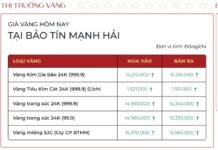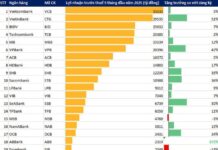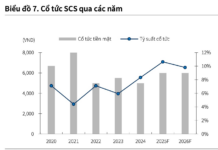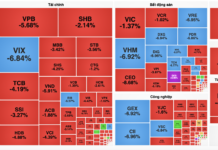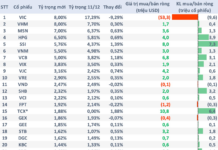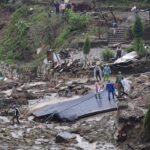Storms and floods have been wreaking havoc in many localities, causing extensive damage to vegetable gardens and leading to a scarcity of supply. At markets in Hanoi, green vegetables and root crops are currently very expensive.
On the morning of September 11th, Ms. Nguyen Ngoc Mai from Linh Dam, Hoang Mai district, shared that she was shocked to pay 130,000 VND for a single green gourd. “I didn’t ask specifically, but I estimate the gourd weighed a little over 3 kg, which works out to more than 40,000 VND per kg. Normally, green gourds cost only about 15,000 – 20,000 VND per kg. I’ve never bought such an expensive gourd before,” she said.
It’s not just green gourds that have seen a price hike; Napa cabbage now costs nearly 30,000 VND per kg, up from the usual 15,000 VND. “I spent 170,000 VND on just one gourd and one cabbage. If prices keep rising like this, I won’t dare go to the market anymore. Today, vegetable prices are as high as meat prices,” Ms. Mai lamented.
Ms. Mai also noted that the quality of the vegetables today was not as good as usual; they looked wilted and bruised. When asked about it, the vendors explained that the outer suburbs and provinces surrounding Hanoi, which are the main suppliers of green vegetables, have been flooded, leading to a shortage of produce. The little that is available has also been affected by the storms and floods.
Ms. Nguyen Thuy Linh from Cau Giay, Hanoi, shared that on the morning of September 11th, the prices of vegetables, roots, and fruits at Nghia Tan market (Cau Giay district) continued to rise, and the supply was even scarcer than the day before. According to Ms. Linh, many people are buying and stockpiling, causing vegetable prices in the market to be higher than in supermarkets. “Normally, I buy water spinach for 10,000 VND per bundle and tomatoes for 35,000 VND per kg, but now the price of water spinach has gone up to 35,000 VND per bundle, and tomatoes are 55,000 VND per kg,” she said.
“Similarly, each bundle of mustard greens is sold for 23,000 VND, while the usual price is around 10,000 VND. Okra is priced at over 20,000 VND per bundle, double the normal price. Green onions cost 55,000 VND per kg, a 10,000 VND increase per kg compared to pre-storm prices. Other root crops like taro, Napa cabbage, and carrots have also increased slightly, by about 5,000 – 10,000 VND per kg,” Ms. Linh added.

Green vegetables continue to be expensive and scarce. (Illustrative image)
However, Ms. Mai considered herself lucky to still be able to buy vegetables at this time. The day before, when she passed by a small market near her house, she noticed that there was no produce left for sale. This morning, she had to go to the market early, but the selection of green vegetables was still very limited, with slightly more root crops available.
Ms. Minh Hoa, a trader at Thanh Tri market in Hoang Mai district, shared that the storms and floods have destroyed vegetable crops, leading to a scarcity of supply, even at wholesale markets. Vegetable prices have been increasing daily, and if the flood situation persists, they could become even more expensive due to the limited availability.
“Since the storm hit, the prices of green vegetables like water spinach, okra, and sweet leaf have been rising daily. Today, I bought water spinach for 28,000 VND per bundle, but customers are still rushing to buy it because the quantity is limited. I only add a small margin of 1,000 – 2,000 VND per bundle to cover costs, as the supply is challenging and consumer demand is high,” Ms. Hoa shared.
According to Ms. Hoa, the continuous rain over the past few days has made it difficult for farmers to harvest their produce and for traders to transport goods. Additionally, many areas have been flooded, so while roots and tubers are still available, green vegetables are scarce, leading to increased prices across the board, with some items costing two to three times the usual amount.
It’s not just green vegetables that are hard to come by these days; seafood is also in short supply. Ms. Nguyen Mai Hong, a trader at Nam Du market in Hoang Mai, Hanoi, shared that seafood prices have also risen significantly due to limited supply. Specifically, the price of squid eggs has increased from 250,000 VND/kg to 300,000 VND/kg, peeled shrimp (large size) has gone up from 310,000 VND/kg to 360,000 VND/kg, and yellow sea shrimp has risen from 220,000 VND/kg to 260,000 VND/kg…
Despite the price increase, the supply of seafood is also limited. Ms. Hong used to buy around 20-30 kg of seafood daily, but now she has to go to the market at 2-3 am, and even then, she can’t get her usual quantity.
According to Ms. Hong, the supply of seafood to the markets is not yet abundant because most boats and ships have been avoiding the storms and have not resumed operations. “The seafood available is mostly frozen or shellfish like snails and clams. In a few days, when the fishermen go out to sea again, we’ll have more fresh catch,” she said.
In contrast to the scarcity of vegetables and seafood, the prices of pork, chicken, and eggs remain stable. Specifically, pork products like ribs and belly pork are priced at 145,000 VND/kg, shank at 140,000 VND/kg, haunch at 120,000-130,000 VND/kg, industrial chicken at 80,000 VND/kg, and red eggs at 25,000 VND/10 eggs…
According to some traders, the prices of meat have remained stable during the storms and floods due to a consistent supply from multiple livestock farms.
Ministry of Industry and Trade advises against hoarding essential goods beyond necessary levels
The supply of essential goods in some northern provinces and cities is assured, with no significant price fluctuations. The Ministry of Industry and Trade advises against hoarding essential goods beyond necessary levels to prioritize support for areas severely affected by Storm No. 3.
The Ministry of Industry and Trade maintains close communication and provides guidance to the Departments of Industry and Trade, distributors, and suppliers to update the situation of goods in the provinces and cities affected by the storm, especially in Thai Nguyen, Lao Cai, Yen Bai, and several other provinces, to ensure the supply of essential goods to these localities…,” said Mr. Bui Nguyen Anh Tuan, Deputy Director of the Domestic Market Department (Ministry of Industry and Trade).
The Industry Unites: Responding to Northern Floods
In the coming days, the northern mountainous and midland regions of Vietnam are expected to experience heavy rainfall, with totals ranging from 100 to 200 mm, and even exceeding 350 mm in some areas. This extreme weather conditions pose a significant threat of flash floods, landslides, and localized flooding in low-lying areas. The potential for large-scale flooding, mudslides, and landslides is extremely high, and residents in these regions should prepare for potential disasters and remain vigilant.
Crafting a Compelling Title: “Mobilizing National Reserves in Response to Typhoon No. 3”
The General Department of State Reserves has dispatched an urgent communiqué to 15 regional state reserve bureaus, gearing up to tackle the impending Typhoon No. 3. The bureaus are strategizing to mobilize national reserve supplies and mitigate the impending flood damage.






